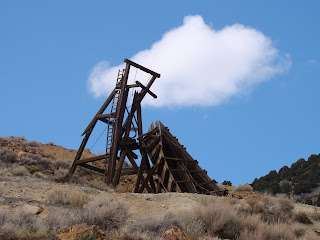The Yellow Jacket Mine

In the 1800's, the large mines of the Comstock employed anywhere from 500 to 1000 men working in shifts around the clock to mine the precious ore. These mines were like ant colonies of underground activity. The men dug and blasted their way down into the earth, using forests of lumber to shore up the walls and work areas, called "cribs" with massive wooden beams and planks. The cribs were interconnected by miles of tunnels and wooden staircases, which in turn, interconnected the levels. Mines extended down hundreds of feet below the surface. Tons of dirt and ore were continually being moved through these pathways by means of chutes and winzes. Scores of wooden flues were constructed through out to dissipate the tremendous heat and to pipe in breathable air. The only light source came from candles or oil filled lanterns. It was a dangerous existence. Fire and cave-ins were a constant threat. Newly discovered ore veins needed to be blasted open and the wooden supports holding up the walls could buckle under the tremendous weight of the earth. One of the worst mine disasters of the Comstock happened on the morning of April 7, 1869; when a fire broke out in the Yellow Jacket Mine.
The fire started around the 800-foot level, near the line of the Kentuck Mine. It was supposed that a candle had been left burning too close to a supporting timber by one of the night shift. The fire was discovered around 7 a.m. by the oncoming day shift. The fire alarm was sounded but not before a number of men had already been lowered into the mine. The fire, once it took hold, roared through the shafts of the Yellow Jacket and the neighboring Kentuck and Crown Point Mines. The flames, along with the heat and smoke hindered rescue attempts, and an estimated 34 men lost their lives, although other accounts have put the number as high as 45. The fires continued to burn for months afterward; however, the miners went back to work in the mines 3 weeks later, such was the lure of gold.

Today, all that is left of the Yellow Jacket Mine is the incline chute and head frame. The wooden chutes leading down the hill once carried ore from the head frame at the shaft on top of the hill. At the bottom of the hill is the Miner's Cabin, which once served as a break shack for miners between shifts. It has become a part of the Gold Hill Hotel, and is nowadays rented out to guests.

Places where tragedies have occurred are said to be prime areas where residual hauntings can be found. It is thought that the high paranormal activity surrounding the Gold Hill Hotel can be directly related to that tragic fire of 1869. Is this true? Do the ill-fated miners remain at the scene of their death? Many visitors seem to think so. W.I.G.S. wanted to find out if the stories of the haunted Yellow Jacket Mine are true. And so, we returned to Gold Hill in April of this year - incidentally, the 140th anniversary of the fire- to investigate Miner's Cabin and the skeletal remains of the Yellow Jacket Mine.
Next: The Investigation



Comments